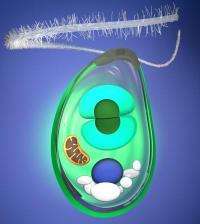February 17, 2012 report
Plants may have a single ancestor

(PhysOrg.com) -- An international group of scientists has analyzed the DNA of primitive microscopic algae, and their findings suggest that all plants on Earth may have had a single ancestor.
There has been a debate among scientists since the 1960s about how the first plant species arose between 1 and 1.5 billion years ago. The most widely accepted idea is that the plant kingdom had a single ancestor that formed when a plastid joined in a symbiotic union with a cyanobacterium, and the new research lends weight to this hypothesis.
Plastids are a class of organelles that includes chloroplasts. Chloroplasts produce the green color of plants and green algae because they contain the pigment chlorophyll, which is able to convert energy from light into energy useful to the cell, in a process known as photosynthesis.
Plastids are found in all green plants, the glaucophytes, and in red algae, and are known as primary plastids. They were originally cyanobacteria, which became incorporated into the cell. The glaucophytes are a group of microscopic blue-green algae found in freshwater, and only 13 species are known, none of which is common. They have been little studied, even though some scientists have suggested they may be the most similar to the original algae that first incorporated a cyanobacterium.

The research team was led by bioinformaticist Dana Price of the Bhattacharya Laboratory at Rutgers University in New Jersey in the US. Price’s team analyzed the DNA of plastids from the glaucophyte Cyanophora paradoxa, one of the most primitive algae known, and compared it to that of plastids from other algae, both red and green, and from various land plants.
The DNA analysis of the C. paradoxa plastid showed it retains hints of its evolution from the earliest cyanobacteria, since it includes genes required for fermentation and starch biosynthesis, but they also found that the DNA includes genes similar to those from ancient bacteria similar to the Chlamydiae bacteria.
The genes sourced from Chlamydiae-like bacteria enable the products of photosynthesis taking place in the plastid to be exported to the rest of the cell, and they also enable the photosynthate to be polymerized into polysaccharides for storage.
The genetic analysis suggests the incorporation of the cyanobacterium must have occurred just once and that it required cooperation between the host cell, the photosynthesizing cyanobacterium, and a Chlamydia-like bacterium. The cyanobacterium (now called a plastid) provided food from sunlight, and the other bacterium made the products of photosynthesis available to the host.
Dr Bhattacharya, after whom the laboratory at Rutgers University is named, said that the three components together formed the new organelle, but that genes would also have been recruited from multiple sources before cell walls were developed. Around 60 million years ago an amoeba called Paulinella also incorporated a photosynthesizing cyanobacterium, and the Bhattacharya Laboratory is now analyzing this amoeba to try to better understand the process.
The paper was published in the journal Science.
More information: Cyanophora paradoxa Genome Elucidates Origin of Photosynthesis in Algae and Plants, Science 17 February 2012: Vol. 335 no. 6070 pp. 843-847. DOI: 10.1126/science.1213561
ABSTRACT
The primary endosymbiotic origin of the plastid in eukaryotes more than 1 billion years ago led to the evolution of algae and plants. We analyzed draft genome and transcriptome data from the basally diverging alga Cyanophora paradoxa and provide evidence for a single origin of the primary plastid in the eukaryote supergroup Plantae. C. paradoxa retains ancestral features of starch biosynthesis, fermentation, and plastid protein translocation common to plants and algae but lacks typical eukaryotic light-harvesting complex proteins. Traces of an ancient link to parasites such as Chlamydiae were found in the genomes of C. paradoxa and other Plantae. Apparently, Chlamydia-like bacteria donated genes that allow export of photosynthate from the plastid and its polymerization into storage polysaccharide in the cytosol.
Journal information: Science
© 2011 PhysOrg.com











.jpg)




